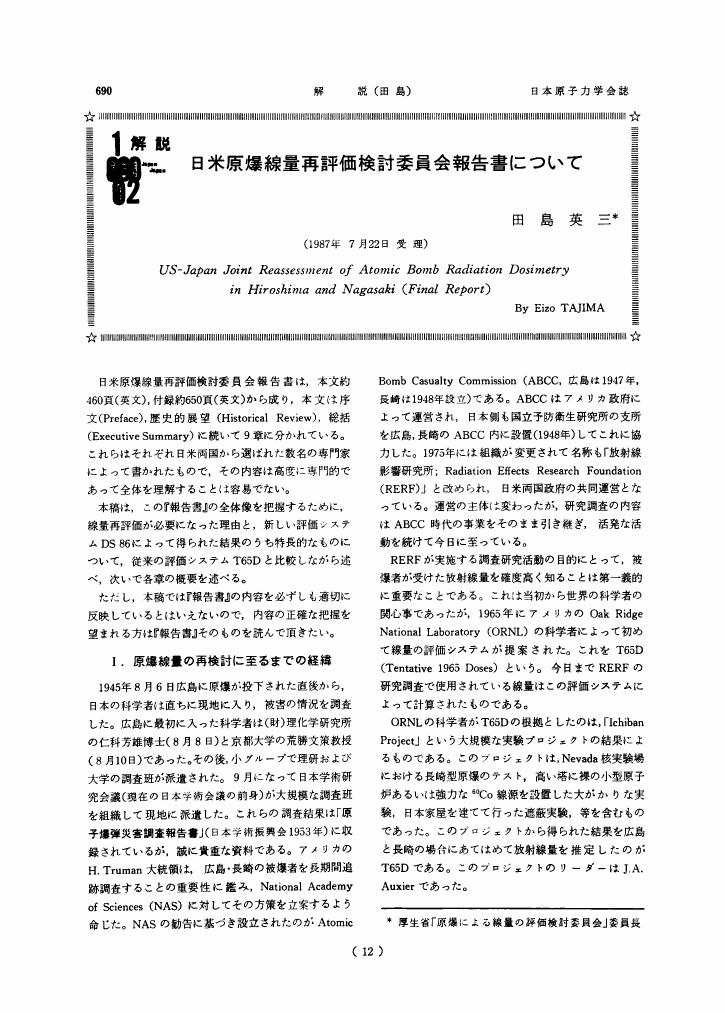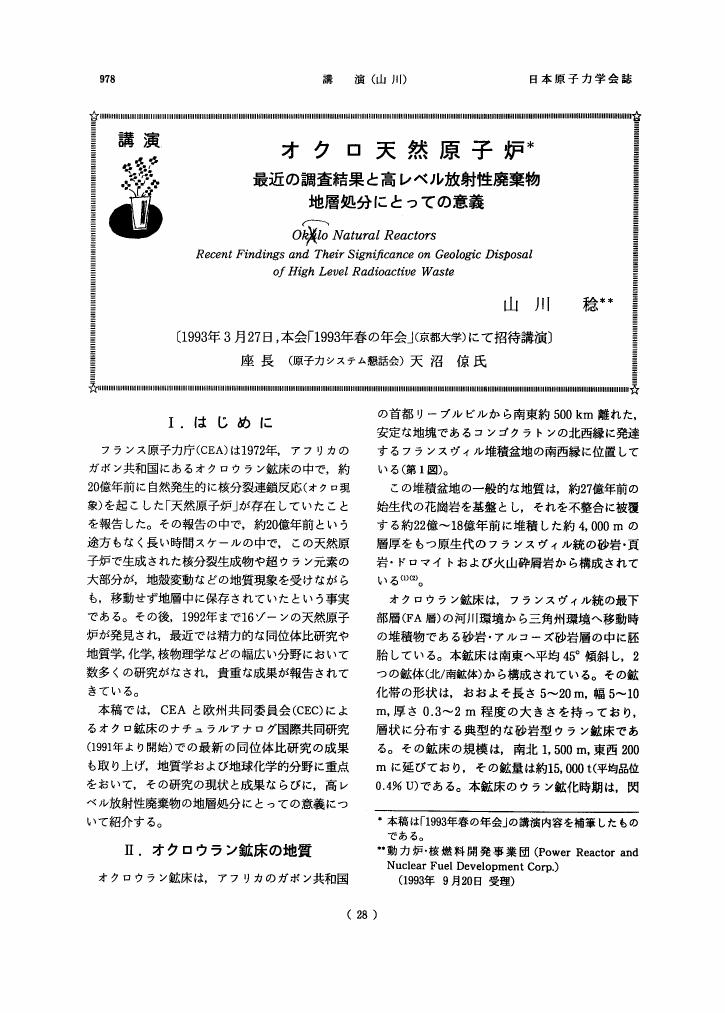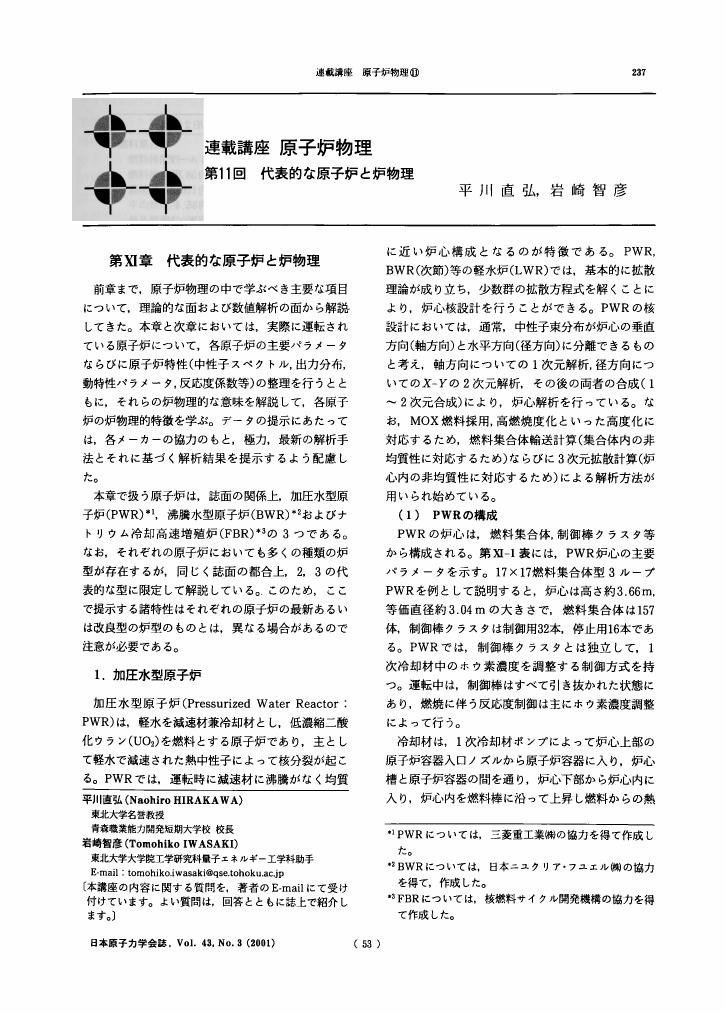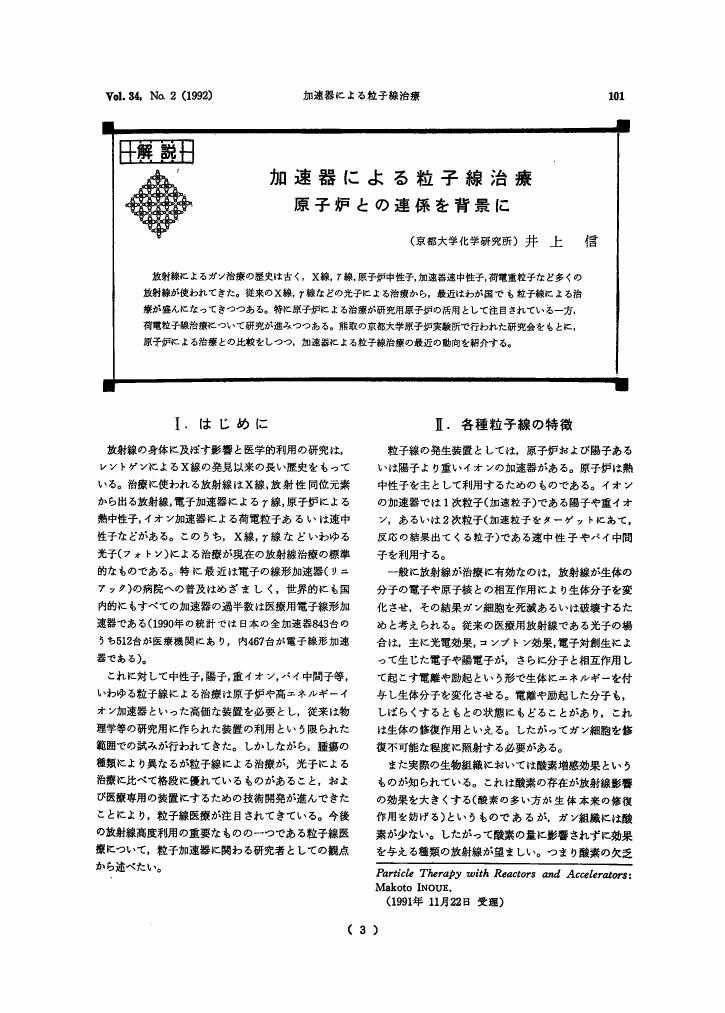2 0 0 0 日米原爆線量再評価検討委員会報告書について
- 著者
- 田島 英三
- 出版者
- 一般社団法人 日本原子力学会
- 雑誌
- 日本原子力学会誌 (ISSN:00047120)
- 巻号頁・発行日
- vol.29, no.8, pp.690-701, 1987
2 0 0 0 OA 核爆発実験により生じた放射性降下物の定量, (I)
- 著者
- 上野 馨
- 出版者
- 一般社団法人 日本原子力学会
- 雑誌
- 日本原子力学会誌 (ISSN:00047120)
- 巻号頁・発行日
- vol.2, no.2, pp.67-72, 1960-02-29 (Released:2009-03-27)
- 参考文献数
- 10
The gamma-ray spectrum emitted by present-day pine leaves reveals the presence of several peaks which do not belong to any naturally occurring nuclide. These peaks come from radioactive fission produts produced from nuclear weapon tests.The gamma-ray spectra of pine leaves collected in 1958 and 1959 show two remarkable peaks. 0.13 MeV peak is actually a combination of peaks of 131Ce and 144Ce-144Pr, while 0.76 MeV peak is assigned as a peak of 95Zr-95Nb.The decay curves of the gamma activity at 0.76 MeV correspond to curves of 95Zr-95Nb with half-life of 65 days. One gram pine leaves ash contains 26 mμc 95Zr-95Nb.
2 0 0 0 OA 重水素およびトリチウム分離技術の現状
- 著者
- 磯村 昌平
- 出版者
- 一般社団法人 日本原子力学会
- 雑誌
- 日本原子力学会誌 (ISSN:00047120)
- 巻号頁・発行日
- vol.23, no.7, pp.483-488, 1981-07-30 (Released:2009-04-21)
2 0 0 0 OA 尿中のトリチウムの定量
- 著者
- 上野 馨 矢部 明 弦巻 一郎 張 昭鼎
- 出版者
- 一般社団法人 日本原子力学会
- 雑誌
- 日本原子力学会誌 (ISSN:00047120)
- 巻号頁・発行日
- vol.3, no.9, pp.688-690, 1961-09-30 (Released:2009-03-26)
- 参考文献数
- 12
尿中に水の型で含まれているトリチウムを,液体シンチレーション法で定量した。尿中に含まれる無機,有機塩類による消光作用を少なくするために1:2陽陰両イオン交換樹脂混合樹脂柱(ダイヤイオン, 100~200メッシュ, HおよびOH型, φ1cm, h10cm)を通して脱イオン化し,純化された尿1mlにつき60mlの液体シンチレータ(4gのPPOと15mgのPOPOPを230mlのエタノール, 770mlのトルエンの混合溶液に溶解したもの)を加え,室温で放射能を測定する。この方法により0.01μc/ml尿のトリチウムを室温で±10%の誤差で定量できる。さらにこの方法は放射性廃液中のトリチウムの定量にも利用できる。
2 0 0 0 原子力施設と放射性ルテニウム
- 著者
- 渡利 一夫 星野 忠也 木下 睦 岩島 清 本田 嘉秀
- 出版者
- Atomic Energy Society of Japan
- 雑誌
- 日本原子力学会誌 (ISSN:00047120)
- 巻号頁・発行日
- vol.18, no.6, pp.336-345, 1976
原子力開発,それに伴う核燃料再処理工場の稼動,そして低レベル放射性廃液の海洋放出による環境汚染等の問題から放射性Ruの重要性が認識されている。本稿は,放射化学,核燃料再処理,保健物理あるいは海洋放射生態学等の分野における放射性Ruの研究の実情を,それぞれの観点からまとめたものである。
2 0 0 0 OA 多方面へ展開する原子炉利用原子炉の熱と光がもたらす可能性
2 0 0 0 OA 計算科学手法と原子力分野における応用 第5回 離散系のシミュレーション手法 (その1)
- 著者
- 山本 敏久 森 貴正
- 出版者
- 一般社団法人 日本原子力学会
- 雑誌
- 日本原子力学会誌 (ISSN:00047120)
- 巻号頁・発行日
- vol.48, no.8, pp.579-585, 2006 (Released:2019-04-05)
2 0 0 0 OA 反応度事故に対する安全性研究
- 著者
- 石川 迪夫
- 出版者
- 一般社団法人 日本原子力学会
- 雑誌
- 日本原子力学会誌 (ISSN:00047120)
- 巻号頁・発行日
- vol.12, no.5, pp.276-283, 1970-05-30 (Released:2010-04-19)
- 参考文献数
- 36
The report discuss research activities objected to nuclear reactivity accidents and examines a program for increasing nuclear safety.Destructive test results are described to afford an general concept of reactivity accidents. The SPERT-CDC experiments are cited as a new form of research program to gain a more detailed and clear insight into the accident behavior. The relaionship between excursion power, fuel rupture and destructive energy is also discussed.Attenion is drawn to the increasing importance of reactivity accident analyses for advanced type reactors, such as large light water power reactors. The report presents reactivity accident programs by pulse reactors such as CDC, PBF, TREAT and NSRR (Japan). Finally an outline of the NSRR program is given.
2 0 0 0 OA オクロ天然原子炉とその現状
- 著者
- 藤井 勲
- 出版者
- 一般社団法人 日本原子力学会
- 雑誌
- 日本原子力学会誌 (ISSN:00047120)
- 巻号頁・発行日
- vol.27, no.4, pp.304-324, 1985-04-30 (Released:2010-01-08)
- 参考文献数
- 25
2 0 0 0 OA 日米原爆線量再評価検討委員会報告書について
- 著者
- 田島 英三
- 出版者
- 一般社団法人 日本原子力学会
- 雑誌
- 日本原子力学会誌 (ISSN:00047120)
- 巻号頁・発行日
- vol.29, no.8, pp.690-701, 1987-08-30 (Released:2009-04-21)
2 0 0 0 OA オクロ天然原子炉 最近の調査結果と高レベル放射性廃棄物地層処分にとっての意義
- 著者
- 山川 稔
- 出版者
- 一般社団法人 日本原子力学会
- 雑誌
- 日本原子力学会誌 (ISSN:00047120)
- 巻号頁・発行日
- vol.35, no.11, pp.978-984, 1993-11-30 (Released:2010-04-19)
- 参考文献数
- 26
- 被引用文献数
- 1 1
2 0 0 0 OA 原子力プラントにおけるLeak-Before-Break概念の適用
- 著者
- 矢川 元基
- 出版者
- 一般社団法人 日本原子力学会
- 雑誌
- 日本原子力学会誌 (ISSN:00047120)
- 巻号頁・発行日
- vol.27, no.8, pp.688-693, 1985-08-30 (Released:2009-04-21)
- 参考文献数
- 5
- 被引用文献数
- 2 3
2 0 0 0 OA 原子力災害時における甲状腺防護剤としての安定ヨウ素
- 著者
- 今堀 彰
- 出版者
- 一般社団法人 日本原子力学会
- 雑誌
- 日本原子力学会誌 (ISSN:00047120)
- 巻号頁・発行日
- vol.30, no.2, pp.135-139, 1988-02-29 (Released:2009-03-31)
原子力災害時における一般公衆を対象とした防護対策の一環として,チェルノブイリ原発事故で一躍脚光を浴びたヨウ素剤の使用がある。これは原子炉事故時に周辺環境に放出される放射性ヨウ素による周辺住民の甲状腺内部被曝を防護する目的で,安定ヨウ素(KI, KIO3等)を周辺住民に対して事前あるいは事故直後に配布し服用させるものである。本稿では,一般公衆を対象としたヨウ素剤使用計画の現況を紹介し問題点を検討する。
2 0 0 0 OA 連載講座 原子炉物理
- 著者
- 平川 直弘 岩崎 智彦
- 出版者
- 一般社団法人 日本原子力学会
- 雑誌
- 日本原子力学会誌 (ISSN:00047120)
- 巻号頁・発行日
- vol.43, no.3, pp.237-249, 2001-03-30 (Released:2009-04-21)
- 被引用文献数
- 2 2
2 0 0 0 OA 関西電力(株)高浜発電所PR館
- 著者
- 奥村 稜應
- 出版者
- 一般社団法人 日本原子力学会
- 雑誌
- 日本原子力学会誌 (ISSN:00047120)
- 巻号頁・発行日
- vol.25, no.3, pp.186-188, 1983-03-30 (Released:2009-04-21)
2 0 0 0 OA 超小型高速炉(4S-50MWe)の設計構想
- 著者
- 服部 禎男 湊 章男
- 出版者
- 一般社団法人 日本原子力学会
- 雑誌
- 日本原子力学会誌 (ISSN:00047120)
- 巻号頁・発行日
- vol.36, no.10, pp.926-938, 1994-10-30 (Released:2009-04-21)
- 参考文献数
- 19
This report describes current status of the design of a 4S (Super Safe, Small and Simple Fast Reactor). The 4S is a fast reactor generating 50MWe electric power, which pursues simple operation system, less maintenance service, higher safety and improved economic features. To satisfy these special characteristics, a new plant concept is produced, where adoption of metallic fuel core and burnup control by annular reflector can ensure negative sodium void reactivity coefficient for the reactor core. The power is controled by the turbine system (water-steam system) alone without any control rod. Complicated fuel handling system and driving mechanism of control rod are eliminated. And the activity of operating service is also eliminated by the application of passive system to the reactor design. The 4S has a substantial safety and is a fast reactor in which fuel is confined for a long time of 10yr as the refueling interval, to realize high proliferation resistance of nuclear material.
2 0 0 0 OA イオン交換による放射性廃液の処理
- 著者
- 岩井 重久 大塩 敏樹
- 出版者
- 一般社団法人 日本原子力学会
- 雑誌
- 日本原子力学会誌 (ISSN:00047120)
- 巻号頁・発行日
- vol.3, no.2, pp.117-128, 1961-02-28 (Released:2009-03-26)
- 参考文献数
- 201
- 被引用文献数
- 1
The process treating radioactive liquid wastes by ion exchange has been widely adopted, alone or combined with another sort of processes, especially when the wastes contain rather low concentration of electrolytes, for which the decontamination factor is rather high by this process, even with lower treatment cost, in comparison with the others.(1) Among various ion exchangers, inorganic one is more economical for this purpose than organic one, if no regeneration of the exchanger is practised in the process.(2) The coprecipitation method and pH control are added properly to the process with cation exchangers, of which selective characteristics can remove some of specific nuclides in the wastes, very effectively.(3) The desalting systems in combination of cation and anion exchangers in a two-bed or a mixed-bed give higher decontamination factor, while the ion exchange membrane can treat highly concentrated wastes more economically.(4) In general, low level wastes can be treated reasonably with cheaper cation exchangers only, with the coprecipitation method.(5) The decrease of the exchange capacity by strong radioactivity is especially remarkable on anion resins.(6) Quite a few studies have been performed to remove radioactivity in the wastes by soils or soil forming minerals, with their ion exchange capacity. Furthermore, by utilizing such a natural capacity of soils, the wastes have been directly disposed into the ground.In this paper, the past history, the present status and the future prospect on the treatment of the wastes by ion exchange process are reviewed, summarized and discussed in the six categories as stated in the above.
2 0 0 0 OA 各国の原子炉立地基準の動向
- 著者
- 都甲 泰正
- 出版者
- 一般社団法人 日本原子力学会
- 雑誌
- 日本原子力学会誌 (ISSN:00047120)
- 巻号頁・発行日
- vol.15, no.8, pp.525-533, 1973-08-30 (Released:2010-04-19)
- 参考文献数
- 16
2 0 0 0 〔56〕高速炉の吸収・制御材:ディミトロフグラード会議をめぐって
- 著者
- 秋元 勇巳 植松 邦彦
- 出版者
- Atomic Energy Society of Japan
- 雑誌
- 日本原子力学会誌 (ISSN:00047120)
- 巻号頁・発行日
- vol.16, no.3, pp.128-136, 1974
A review is presented of the IAEA-IWGFR Specialists' Meeting on the "Development and Application of Absorber Materials for Fast Reactors" which was held at Dimitrovgrad, USSR, June 4-8, 1973. At the meeting, attention was given mainly to the choice of absorbing materials for the control elements of fast reactors, to the design of absorbing rods and tests of their performance.<BR>About two thirds of the sessions were devoted to the oldest established and the most promising absorber-B<SUB>4</SUB>C. The pre-irradiation properties of B<SUB>4</SUB>C are considered to be fairly thoroughly known already. Good agreement has been seen on the results of compatibility studies. On the other hand, the irradiation behavior of B<SUB>4</SUB>C-specially swelling and He release-stimulated brisk discussion among the participants in respect of the appreciable discrepancy discerned in the results obtained so far and the possible explanations given therefore. Development of the vented control rod is being actively undertaken in most of the countries.<BR>Tantalum and Eu<SUB>2</SUB>O<SUB>3</SUB> attracted attention as promissing alternatives to B<SUB>4</SUB>C. There arises problems, however, on the compatibility of these two materials in the presence of Na. Another difficulty foreseen in the use of Ta rods is cooling during reactor shut-off. For Eu<SUB>2</SUB>O<SUB>3</SUB>, phase stability should be an important problem for future study.
2 0 0 0 OA 加速器による粒子線治療原子炉との連係を背景に
- 著者
- 井上 信
- 出版者
- 一般社団法人 日本原子力学会
- 雑誌
- 日本原子力学会誌 (ISSN:00047120)
- 巻号頁・発行日
- vol.34, no.2, pp.101-107, 1992-02-29 (Released:2010-04-19)
- 参考文献数
- 11










